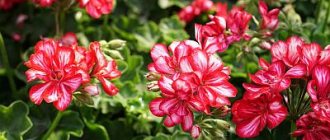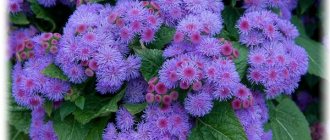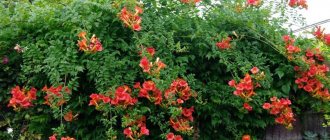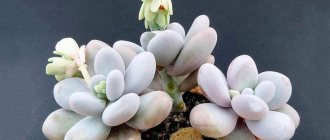Author: Elena N. https://floristics.info/ru/index.php?option=com_contact&view=contact&id=19 Category: Houseplants Published: January 16, 2019Last edits: January 11, 2021
- Growing from seeds
- Clerodendrum does not bloom
- Thomson's clerodendrum (Clerodendrum thomsoniae)
The plant clerodendrum (lat. Clerodendrum) , or clerodendron , is a deciduous or evergreen tree or shrub of the Verbenaceae family of the order Lamiaceae. In nature, clerodendrum flowers are found mostly in the tropics of Africa, Asia and South America. In total, about 400 species of clerodendrum are known. The name of the plant is translated as “tree of fate”; it is sometimes called “volkameria” or “innocent love”. Although clerodendrum was introduced into culture several centuries ago, the clerodendrum flower has been grown as a house plant not so long ago, but its popularity in this role among flower growers and designers is growing very quickly.
Planting and caring for clerodendrum
- Flowering: from June to early autumn, fragrant clerodendrum blooms almost all year round.
- Lighting: bright diffused light (eastern and western window sills, shading required on the southern window).
- Temperature: 18-25 ˚C during the period of active growth and flowering, 13-15 ˚C during the dormant period.
- Watering: abundant, the top layer of the substrate should dry out between waterings.
- Air humidity: high, requiring nightly spraying in the warm season and keeping away from heating devices in winter.
- Feeding: from mid-spring to late summer, twice a month with complex mineral fertilizers for flowering plants.
- Dormant period: after flowering - in autumn and winter.
- Pruning: at the beginning of the growing season.
- Transplantation: at the beginning of active growth: young plants are replanted annually, adults - every 2-3 years.
- Reproduction: seeds and cuttings.
- Pests: aphids, whiteflies and spider mites.
- Diseases: chlorosis, rot.
Read more about growing clerodendrum below.
Common mistakes gardeners make
Clerodendrum, of course, is undemanding, but mistakes by inexperienced gardeners often negatively affect the decorativeness of the plant.
Table: frequently asked questions when growing clerodendrum
| Problem | Most Likely Cause |
| Individual areas of the leaves lighten, then dry out and die. | The plant was exposed to direct sunlight and suffered burns. If it is located on a south-facing window, try to water it so that the drops do not fall on the leaves. They act as lenses, focusing the rays. |
| The shoots become thinner and stretch out. The distance between the leaves increases, they become smaller. | Clerodendrum lacks light and/or nutrition. |
| The leaves wither, turn yellow, fall off, the buds dry out without blooming. | If only the lower leaves fall, and this happens in winter, the situation is normal. Otherwise, you are not watering the plant enough. |
| Light spots of irregular shape on the leaves. | The room temperature is too low and/or there are cold drafts. |
| Lack of flowering. | Clerodendrum was not provided with a period of rest of sufficient duration in compliance with all conditions. Another option is a lack or, conversely, an excess of nutrients in the soil. The latter can be determined by the increased size and darkened leaves. |
Features of cultivation
- The leaves of clerodendrum are bright green, simple, heart-shaped, with jagged or solid edges, a rough “quilted” surface, 20 to 30 cm long, arranged oppositely or whorled on the stem. Flexible shoots in the lower part become woody very quickly. The indoor clerodendrum flower is grown for its beautiful flowers with long stamens, collected in terminal corymbs or racemes.
- Clerodendrum flowers in most species have the shape of a butterfly, but in Clerodendrum philippines and Clerodendrum benguet the inflorescences resemble bouquets of unusual shapes.
- Both flowers and leaves of most clerodendrums emit a scent, and each species has its own.
- The indoor flower clerodendrum is represented mainly by two species - Thompson's clerodendrum and brilliant clerodendrum, although other representatives of the genus grow well at home.
- Clerodendrum can be given various forms (ampeloid, bush-like, standard) using pruning and pinching.
- Caring for clerodendrum flowers is not difficult - they are hardy, unpretentious and at the same time fabulously beautiful and also fragrant.
How to form a bush?
TIP : Natural form of vine. At home, you can grow an ampel plant with freely hanging wattles or fix it, giving the desired direction for growth.
The plant is easy to shape. May be in the form of a bush or standard tree:
- Standard form - one strong shoot is enough for a young plant. Tie it to a vertical support. Cut off other shoots. When the plant is half a meter tall, cut off the top. For intensive branching, pinch the growing points. Periodically remove shoots that are below the desired crown level.
- Shrub – Shorten shoots to your desired height when pruning. To get a thicker bush, pinch out the side branches.
For a beautiful bush, follow these rules:
- The first pruning should be done with the arrival of spring. Shoots that have become woody need to be shortened by a third. This will stimulate flowering. The desired type of plant will be formed by subsequent pruning and pinching.
- The plant will form an ampel shape on its own, without your help. Prune shoots before dormancy for good growth. Do this in early March or when the plant has already lost its leaves.
- For the bush we leave 3 strong woody shoots. cut out the rest. We shorten the remaining ones by a third. Pinch the tops of green branches as they appear. This promotes tillering. The bush will be thicker and more luxuriant if you do not cut out the root shoots. If the bush has become very thick, simply cut out several shoots from its middle.
Caring for clerodendrum at home
Rules of care
For healthy growth and full flowering, tropical forest plants need conditions that are as close to natural as possible. Clerodendrum at home prefers window sills facing south, west or east - it needs bright light, but with protection from direct sunlight. The optimal temperature in summer is between 18-25 ºC; during the dormant period, which occurs in the winter months, the plant needs coolness - no higher than 15 ºC.
The air humidity in the room with clerodendrum should be high, so you will have to spray the plant with soft, settled water every night in the warm season, and in winter, remove the flower pot away from heating appliances.
Clerodendrum should be watered abundantly with soft water, but the top layer of soil should dry out between waterings. During the dormant period, soil moistening is carried out according to the following principle: the cooler it is in the room, the less often we water it, but the earth ball should not dry out completely. From mid-spring to the end of summer, clerodendrum is fertilized twice a month with complex fertilizers for flowering indoor plants; no fertilizing is needed in autumn and winter.
- Shade-loving indoor plants: care
Clerodendrum flowering
Depending on the species, clerodendrum begins to bloom in June, and these plants fade in September. It is interesting to observe how white bracts appear on the still bare shoots of Thompson's clerodendrum in early spring, from which crimson corollas up to 2.5 cm in diameter are formed. The beautiful clerodendrum blooms from June to September with panicles of purple flowers, and the fragrant clerodendrum blooms almost all year round. Anyone who has seen clerodendrum bloom will definitely want to see this magic again.
Trimming
Caring for clerodendrum involves mandatory annual pruning of the plant at the beginning of the period of active growth. Caring for Thompson's clerodendrum, for example, in addition to removing dried or weak branches, requires shortening all shoots by a third of the length, which should stimulate abundant flowering, as well as intensive growth and branching of young side shoots, on which inflorescences are formed. Clerodendrum is also pruned in order to form a crown - if you want the clerodendrum to grow as a bush, you need to greatly shorten the shoots when pruning in spring, otherwise you will have to install support for them later.
How to prune clerodendrum to make a tree? The standard form is created as follows: all shoots are removed, except for one, the strongest, which is cut off at a height of 50-70 cm, and then all shoots that appear in the apex area are pinched in order to create a crown due to their branching. If sprouts appear on the stem below the crown, they are removed.
Transfer
Growing clerodendrum requires replacing old soil with new soil from time to time; in addition, an overgrown plant may require a larger pot. Plants are replanted at the beginning of active growth after pruning. Young plants need annual replanting, but older plants need to change the soil and pot once every two to three years. The soil for clerodendrum should be nutritious and slightly acidic (pH 5-6). You can use store-bought soil, adding sand to it, or make your own from peat, coarse sand, leaf and clay soil in equal parts.
Before replanting the plant, the new soil must be disinfected by steaming, oven or microwave. How to transplant clerodendrum? Take a pot 2 cm in height and 2 cm in diameter larger than the old one, place a layer of drainage three centimeters high in it and transfer the plant from the old pot to the new one, being careful not to damage the root ball. Add the required amount of new substrate to fill the voids in the pot and water the plant. If your clerodendrum needs support in the future, dig it in when replanting so that you don’t have to stick it into the pot later, damaging the roots of the plant.
Transplant procedure
The optimal time for replanting clerodendrum is early spring, when the flower “wakes up” after a dormant period. Plants under the age of 5 years are replanted annually, each time increasing the diameter of the pot by 2–3 cm. For adult clerodendrums, one transplant every 3–5 years is sufficient.
Simultaneously with replanting, it is advisable to cut each shoot by a third to make the flower more decorative and bushy.
If you purchased clerodendrum in a store, give it 10–15 days to get used to the new environment, then replant. The universal soil used by indoor plant growers does not take into account the specific needs of the flower.
The pot should have a large drainage hole. Place a layer of drainage (expanded clay, pebbles, crushed stone, brick chips, ceramic shards) 3–4 cm thick at the bottom.
Ready-made soil can be purchased in specialized stores. Look for one that is designed for roses and azaleas. They need to be mixed in a 4:1 ratio.
When preparing it yourself, remember that clerodendrum prefers slightly acidic soils, light and breathable. When collecting soil from your own garden, check the acidity level. The soil mixture may look like this:
- Fertile turf, ordinary soil, dry peat, coarse river sand, humus in equal proportions.
- Leaf soil, powder clay, coarse sand, dry peat. The first component needs to be taken twice as much as the others.
The fragile roots of clerodendrum should never be disturbed during transplantation. It is strictly forbidden to shake off the soil from them and/or rinse them with running water. The entire ball of earth is removed from the pot and placed on a layer of substrate in a new pot. The prepared soil is added to the edges and compacted. The transplantation method is known as transshipment.
The support (if needed) is placed in the pot at the same time as the earthen ball, and not stuck in later. Otherwise, there is a high risk of injuring the roots.
Clerodendrum propagation
Reproduction of clerodendrum at home is carried out both by generative (seed) and vegetative (cuttings) methods.
- Cypress: cultivation, propagation, types and varieties
Growing from seeds
Clerodendrum seeds are sown at the end of February or early March in a mixture of turf soil, sand and peat, placed in a greenhouse and kept in good light, ventilating and maintaining moderate soil moisture. You will have to wait a long time for germination - one and a half to two months. When the seedlings have four true leaves, they are planted in separate small containers with a diameter of 6 cm, one seedling at a time or three in a container with a diameter of 11 cm, and as soon as the seedlings have become accustomed and begin to grow, they begin to accustom them to the conditions for adult clerodendrums.
Cuttings
If you already have clerodendrum, you will not need the seed propagation method, because you can always get cuttings for rooting when pruning in spring. Clerodendrum cuttings root easily in water, especially in spring and summer. Once the cuttings have taken root, they are planted in pots approximately 7 cm in diameter and grown under a glass cover, keeping the substrate moist.
As soon as the root system develops and shoots and leaves appear on the cutting, the cutting with the root ball is transferred to a pot with a large (9 cm) diameter, in which it will grow until spring without a cap. A year from the beginning of rooting, transfer the plant to a pot with a diameter of 11 cm in soil for an adult clerodendrum. During this time, be sure to pinch the shoots at least twice to stimulate the growth of side branches.
Where did the handsome clerodendrum come to us from: a little interesting
The Verbenov family contains a lot of all kinds of plants, and one of them is clerodendrum. This tropical bush can easily be found in Africa, South America or Asia, if you are lucky enough to visit there (unfortunately, I did not have such an opportunity, so I have to look at this tropical beauty and dream of distant countries).
Clerodendrum has several hundred species, but almost every year a new one joins them, thanks to the research of botanists. If you are unfamiliar with this plant, then remember if you have ever encountered the Tree of Fate. This is the second name for clerodendrum, I like it better. As far as I know, it is quite possible to predict the future from the leaves of a plant, but only some priests are capable of this. We grow lush bushes for aesthetic pleasure.
Clerodendrum was cultivated almost half a century ago, but it did not gain much popularity. Only 10-15 years ago, amateur flower growers and professional florists began to successfully practice growing the Tree of Destiny.
Pests and diseases
Of all the harmful insects, clerodendrum can be affected by spider mites and whiteflies. Whiteflies hide on the underside of the leaves, and on the top there is a shiny coating from whitefly excrement - honeydew, or honeydew. Spider mites are too small for you to see, but they make their presence known by white dots on the underside of leaf blades and subtle webs on the leaves. You can fight these pests with the same insecticide: dilute one ampoule of Actellik in a liter of water and spray the plant. The treatment can be repeated four times at an interval of three days.
Clerodendrum does not bloom
Very often, on flower forums, beginners try to find out from experienced flower growers why their clerodendrum does not bloom, and each time they are amazed at how simple the reason for their sadness is. Moreover, when they are convinced that everything depends only on them and get down to business, then problems with other colors are solved by themselves. And the reason is always the same: the rules for growing the plant were violated. In the case of clerodendrum, flowering most often does not occur due to improper wintering of the plant.
How to make clerodendrum bloom
So, what to do if clerodendrum does not bloom? In order for your clerodendrum to bloom in the spring, it needs to have a cool winter. As soon as flowering comes to an end, gradually reduce watering the plant and move the flower to a cool room - no warmer than 15 ºC. Optimal conditions for wintering are a temperature of 12 ºC and purely conditional watering only to prevent the plant from drying out. With this maintenance, for one and a half to two months, the clerodendrum will rest and gain strength for a new season of active growth.
As soon as you notice that the clerodendrum has begun to produce new shoots, gradually increase watering, prune and, if necessary, replant the plant, move it to its usual place and resume feeding. Make sure that the soil of the clerodendrum is nutritious - sometimes the plant does not bloom due to the fact that it has not been replanted for a long time. Another reason for delayed flowering and even falling buds may be insufficient lighting.
- Dracaena or Cordyline?
Clerodendrum turns yellow
If clerodendrum leaves turn yellow in spring or summer, the reason may be a lack of moisture in the soil - water the plant more often or more abundantly so that there is always water in the pan. Sometimes the cause of yellow spots on clerodendrum leaves is the disease chlorosis, which can be cured by feeding the plant with iron-containing preparations.
Clerodendrum leaves are falling off
If leaf fall begins after flowering, then most likely this is a natural autumn process for deciduous plants - the leaves turn yellow and fall off throughout the fall and winter, leaving bare shoots. But in spring and summer, the leaves should not fall, so re-read the rules for caring for the plant and correct your mistakes or change the location of the clerodendrum.
Pest Control
Inspect plants regularly for signs of damage and take appropriate action immediately.
Table: the most common pests of clerodendrum
| Pest | Symptoms | Fighting methods | Prevention |
| Spider mite | The pest gnaws through the leaf and sucks out the juice. The underside of the leaf blade is covered with tiny white dots. The leaves and shoots are intertwined with thin, almost transparent threads, similar to a cobweb. In particularly advanced cases, the plant is almost invisible under a dense layer of whitish mass; many pests accumulate on the tops of the shoots. |
| High humidity is detrimental to spider mites. It is useful to give the plant a warm shower every 20–25 days. First, apply a thick foam of laundry soap to the leaves and shoots for 15–20 minutes. |
| Mealybug | The pest is easy to recognize by the small dirty white pellets that appear on the leaves and roots, similar to cotton wool. At the same time, cloudy drops appear on the underside of the leaves. The flower stops growing and the leaves fall off. |
| Proper care. |
| Whitefly | Small flying insects suck sap from plants. Shake the flower and you will find swarms of pests rising into the air. |
| It has been noticed that whiteflies are very attracted to the yellow color. You can make your own trap from a sheet of paper and cardboard by applying glue, Vaseline, or something else sticky to it. |
| Shchitovka | Grayish-brown plaques appear on shoots and leaves. These are the shells of pests that suck the sap of the plant. At the same time, the presence of sticky transparent discharge is characteristic. |
| Proper care. Scale insects will not appear in high humidity and bright light. |
Many acaricides are toxic, so it is best to carry out treatment outdoors.
Photo gallery: clerodendrum pests
Not just any insecticide can “dissolve” the durable shell of the scale insect.
Whiteflies are easy to identify, but quite difficult to get rid of.
Certain varieties of mealybug attack the roots. The pest is difficult to identify until it is too late
To combat spider mites, use special preparations - acaricides
Kinds
Thomson's clerodendrum (Clerodendrum thomsoniae)
The most common species in indoor floriculture, it is a woody deciduous vine with smooth thin shoots. Dark green large dense leaves with clearly visible veins and solid edges have an oblong-ovate pointed shape and reach a length of 12 cm. On the upper side of the leaf plate there are irregularly shaped spots of more or less light shades. White swollen flowers with a red corolla are collected in loose racemes growing from the axils. Thompson's clerodendrum is propagated at home using cuttings, grows very quickly, blooms from March to June.
Clerodendrum splendens
It belongs to evergreen shrubs with climbing shoots, almost round leaves up to 8 cm long and 6 cm wide, having a heart-shaped base, a pointed oblong apex and wavy edges. Scarlet-red flowers are collected in short axillary racemes or corymbose inflorescences. Clerodendrum brilliant blooms almost all year round.
Philippine clerodendrum (Clerodendrum philippinum)
A species with a strong, pleasant jasmine-vanilla aroma that intensifies in the evening. This wonderful representative of the genus, unfortunately, is an infrequent guest in our apartments, although it is not capricious in care and blooms already in the second year of life with pinkish-white inflorescences up to 20 cm in diameter from pinkish flowers with a diameter of 2-3 cm, the beauty and tenderness of which is emphasized by wide dark green leaves.
Ugandan clerodendrum (Clerodendrum ugandense)
A fast-growing evergreen vine that can reach two meters in length. The leaves are dark green, broadly lanceolate, the flowers are collected in loose terminal inflorescences with few flowers and their blue thread-like stamens resemble butterflies with antennae. The upper and side petals of the flowers are blue, and the lower, barely noticeable petal is lilac-blue or violet. This clerodendrum can be given both the shape of a bush and the shape of a tree.
Fragrant clerodendrum (Clerodendrum fragrans)
Evergreen shrub up to two meters high. On the pubescent shoots grow broadly ovate, with deep teeth along the edges, the same pubescent leaves up to 20 cm long. White with a pink tint on the outside, simple or double flowers, exuding an aroma with notes of violet and citrus, collected in dense apical shields up to 8 cm in diameter . This species blooms almost non-stop.
Clerodendrum Wallich, or Clerodendrum Prospero
And also “Cleopatra’s tears”, “bride’s veil” or “bridal veil”, as this species is popularly called, is distinguished by the abundant flowering of snow-white inflorescences, composed of exquisitely shaped flowers. The plant itself is a small graceful bush with tetrahedral shoots and dark green lanceolate leaves 5-8 cm long with a wavy edge that fits on the narrowest windowsill. This is the most difficult species to grow indoors, requiring special daylight hours and high air humidity.
Clerodendrum beautiful, or most beautiful (Clerodendrum speciosum)
An evergreen shrub with tetrahedral shoots reaching three meters in height. Shiny, large heart-shaped leaves on long dull red petioles, covered with hairs. Purple flowers with a dark red corolla are collected in apical panicles. Blooms profusely from June to September.
Description
The Clerodendrum Thompson flower is a fast-growing evergreen vine.
- Type: deciduous.
- Family: Verbenaceae.
- Latin name: Clerodendrum thomsoniae.
- Natural region: South Africa.
The flower stems are very flexible, slightly curly. They can reach 4 meters or more in height. In adult specimens, the stems are most often lignified.
The leaves of this representative of the flora have short petioles, opposite, and emerald hue. The veins are clearly expressed.
Due to their arrangement, the surface of the leaves has a quilted shape. The edges of the leaflets are smooth. The leaf blade is rounded with a slight elongated edge. It reaches no more than 10-13 cm in length.
The plant blooms very long and abundantly - twice a year. Beginning - mid-spring, beginning - mid-autumn.
The buds are located in the middle of the axils of the flowers. They are located on elongated peduncles of stems. Inflorescences in the form of brushes. Each piece contains 6-22 miniature flowers. Flowers with five leaves.
The bract is lantern-shaped, no more than 3 mm in diameter. Inside there is a corolla, shaped like a butterfly. Elongated stamens, slightly more than 2.5-3.5 cm long, protrude from it.
The death of the corollas occurs quite quickly. And snow-white bracts are on Clerodendrum Thompson for 45-60 days. After flowering, round, orange-hued fruits appear. They reach a length of about 1 cm. Each of these fruits produces one seed.
Today, clerodendrum has more than 450 varieties.
On our website you can see some of them:
- Clerodendrum Wallich;
- Clerodendrum Ugandan;
- Clerodendrum philippines.
Decorative foliage plants, which include clerodendrum, attract the attention of most gardeners. We have prepared for you a series of useful materials about such flowers. Read all about Singoinum, Pellionia, Dichorisandra, Duchesnea Tutti Frutti, Scindapsus, Thunbergia, Aeschynanthus, Raphidophora and other representatives of vines.
Watering
Watering clerodendrum should be regular and plentiful.
Stagnation of water is detrimental to the plant, so watering is carried out when the top layer of soil dries out. The interval between waterings in summer can be from one to three days, in winter it is longer and depends on drying out of the soil.
The soil should not be allowed to dry out completely, as this may cause the leaves to fall off.
Water for irrigation is taken soft, settled for at least a day and at a temperature slightly above room temperature - +26o - 28o.
What you need for abundant flowering. Signs and superstitions
Thompson's sclerodendrum does not bloom in unfavorable conditions. The most common mistake novice gardeners make is neglecting the winter dormancy phase. Flower buds do not set in warm weather, and flower stems do not appear in the spring. In winter, the flower should be kept in a cool place. There are three reasons for the lack of flowering:
- Warm wintering;
- Lack of nutrients (potassium and phosphorus).
- Incorrect or insufficient pruning;
To ensure Thompson's clerodendrum blooms, move it to a cooler area in late fall and reduce watering. The soil should be slightly moist. Prune in the fall before dormancy or in early spring before active growth begins. In spring, clerodendrum is returned to a warm place and watering is increased. After the first buds appear, mineral fertilizers are applied.
Flowers form on new shoots, so in spring or autumn all clerodendrum branches are cut back by a third. Without pruning, cold wintering and regular replanting, clerodendrum will not bloom.
Caring for Thompson's clerodendrum during the flowering period consists of regular watering and feeding. Protect the flower from cold and drafts, temperature changes, and drying out of the soil. Wilted flowers that have lost their decorative effect should be removed immediately.
Clerodendrum: how to propagate by seeds
They are usually bought in a store or collected by hand. You also need to know that the longer the seeds lie idle, the harder it is for them to sprout. Therefore, it is advisable to sow, firstly, only new seeds, and, secondly, with a reserve. The optimal time for sowing is the end of winter. Planting pots must be prepared in advance.
Planting process
You can use medium-sized wooden boxes, plastic containers and even glasses. You also need to remember to make holes in the container to drain water. Now a few words about the soil in which the seeds will grow. It should be airy, nutritious and permeable. Prepare a mixture of two parts turf soil, peat and river sand. Everything is mixed and processed. The composition is placed in the oven for twenty minutes at a temperature of one hundred and eighty degrees. After this, the mixture is allowed to cool, poured into planting containers and moistened generously. Next, the seeds are sown. Now the container can be placed in a greenhouse or covered with glass. Condensate is collected in a timely manner.
Possible problems
Important! All problems that may arise with clerodendrum are the result of improper care or the influence of pests.
For example, when the leaves began to turn yellow and fall, and spots formed on them, the reason was improper watering, dry air or temperature fluctuations (you can learn more about the reasons for the yellowing and falling of clerodendrum leaves here). The following parasites also pose a danger to the flower:
- spider mite - it leaves a web on the leaf plate, and the leaves themselves fall off;
- aphid – the plant stops growing and its leaves curl;
- whitefly - leaves turn yellow, curl and fall off.
To solve the problems that arise, spraying is carried out using special chemicals.











